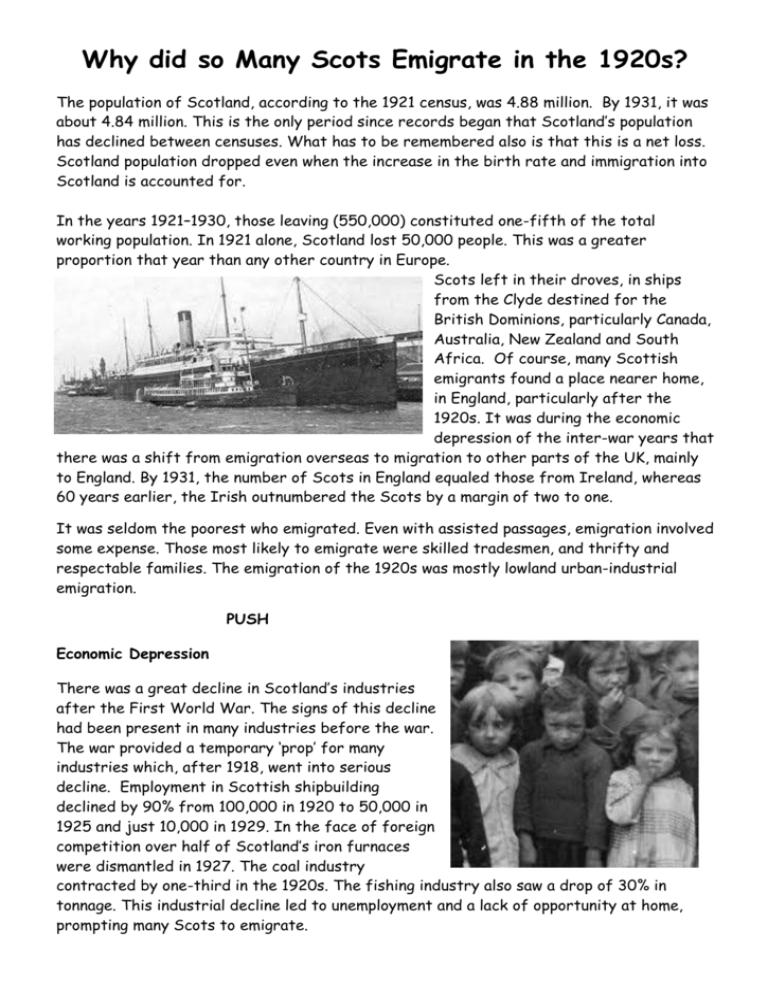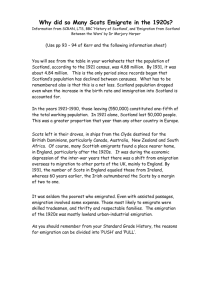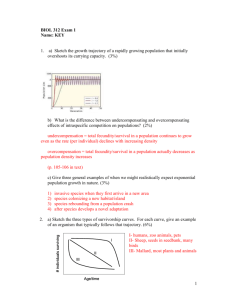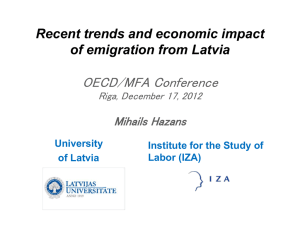File
advertisement

Why did so Many Scots Emigrate in the 1920s? The population of Scotland, according to the 1921 census, was 4.88 million. By 1931, it was about 4.84 million. This is the only period since records began that Scotland’s population has declined between censuses. What has to be remembered also is that this is a net loss. Scotland population dropped even when the increase in the birth rate and immigration into Scotland is accounted for. In the years 1921–1930, those leaving (550,000) constituted one-fifth of the total working population. In 1921 alone, Scotland lost 50,000 people. This was a greater proportion that year than any other country in Europe. Scots left in their droves, in ships from the Clyde destined for the British Dominions, particularly Canada, Australia, New Zealand and South Africa. Of course, many Scottish emigrants found a place nearer home, in England, particularly after the 1920s. It was during the economic depression of the inter-war years that there was a shift from emigration overseas to migration to other parts of the UK, mainly to England. By 1931, the number of Scots in England equaled those from Ireland, whereas 60 years earlier, the Irish outnumbered the Scots by a margin of two to one. It was seldom the poorest who emigrated. Even with assisted passages, emigration involved some expense. Those most likely to emigrate were skilled tradesmen, and thrifty and respectable families. The emigration of the 1920s was mostly lowland urban-industrial emigration. PUSH Economic Depression There was a great decline in Scotland’s industries after the First World War. The signs of this decline had been present in many industries before the war. The war provided a temporary ‘prop’ for many industries which, after 1918, went into serious decline. Employment in Scottish shipbuilding declined by 90% from 100,000 in 1920 to 50,000 in 1925 and just 10,000 in 1929. In the face of foreign competition over half of Scotland’s iron furnaces were dismantled in 1927. The coal industry contracted by one-third in the 1920s. The fishing industry also saw a drop of 30% in tonnage. This industrial decline led to unemployment and a lack of opportunity at home, prompting many Scots to emigrate. Unemployment During the 1920s and 1930s the principal aim of the emigrants was to find work and wages and escape mass unemployment at home. This mostly affected the age group 16–29, skilled rather than unskilled workers and men rather than women. Around the steel town of Motherwell in the 1920s, unemployment rose from under 2,000 to over 12,000. Motherwell became of the worst hit places in Scotland. The unemployed of this town, many of whom were very skilled steel workers, were faced with the choice of working one week in three earning eleven pence a day, burying the dead in the town cemetery, the dole, or emigration. Land Shortage in the Highlands There was a great demand for land in the Highlands after the war. This demand was met with a shortage of available land, landraids and ineffective government action. In 1923, after the tour made by Canadian government emigration agents, there were mass emigrations from Lewis. There was a great deal of hostility in the Highlands, and in particular Lewis, towards the British government’s promotion of emigration instead of land settlement. PULL The Scottish Tradition of Emigration In the period 1903 – 1914 Scotland had also seen the highest proportional emigration of any country in Europe, apart from Norway and Ireland. Scots who emigrated after the war were simply continuing the Scottish tradition of emigration. Family and Friends Nothing was more effective in persuading people to emigrate than encouraging letters from family and friends. Even more effective were remittances (pre-paid tickets) or money sent back by the emigrants to enable others to join them. In 1922 a 19-year old miner named Joseph Delaney and seven other members of his family left Glasgow for the USA with tickets paid for and employment in the USA arranged by Joseph’s uncles. Clusters of emigrants from one family or town built up abroad. A group of Scots from Armadale (in West Lothian) settled in Benton, Illinois, working in the mines, and a community of Broxburn (also in West Lothian) folk grew in Fernie, British Columbia, in the early years of the 20th century. Easier Travel In the 1850s it took around six weeks to cross the Atlantic; by the 1920s it took only a week. The reduction in travelling time allowed for temporary migration as well as permanent something unthinkable in the days of sailing ships. If things did not work out in the New World then the price of a steamship ticket brought you back home in a week. Government Assistance In 1921, the Overseas Settlement Committee was set up in Britain with government support to provide assistance to people who wanted to emigrate. The Committee granted free passage to the Dominions to ex-servicemen and women until the end of March 1923. The scheme assisted over 80,000 emigrants, many of them Scots. The Empire Settlement Act 1922 In the 1920s, the British government saw emigration as a way to strengthen an increasingly fragile British Empire. This act gave government assistance of around £3 million a year for fifteen years to assist emigration schemes. Women were in great demand as domestic servants and as wives; both were in short supply in the early days of the colonies. 20% of the British emigrants to Canada who were assisted by the ESA were female domestic servants, many of whom would have been Scots. Under the ESA the British government also worked in partnership with the governments of the dominions to assist emigration. In 1925 Canada promoted the ‘3,000 Families Scheme’, which aimed to bring 3,000 British families to Canada with the promise of land from the Canadian government and long-term loans of up to £300 from the British government for the purchase of stock and equipment. Scottish emigrants had always had a preference for Canada over the USA, so there were a disproportionate number of Scots who participated in schemes such as this one. In 1924 the government of British Columbia (in Canada) ran a fisheries emigration scheme which targeted Highland fishermen in the Hebrides. Other Assistance Other assisted emigration schemes were run by companies such as the Canadian Pacific Railway Company and the Hudson’s Bay Company (a fur-trading company). Emigration Agents There were hundreds of professional private and government emigration agents. Many of these agents were Scots who had already emigrated. The agents were paid by companies or governments to recruit Scottish emigrants for free or assisted passage schemes, through lectures and posters. A Canadian emigration agent conducted a lecture-tour of the Hebrides in 1923. There were Canadian government emigration offices in Glasgow, Aberdeen and Inverness. The Australian and New Zealand governments promoted their schemes through employment exchanges and ticket agencies, such as Mackay Brothers, which had offices in Aberdeen and Edinburgh. Church and Charity Charities had been organising assisted emigration schemes since the nineteenth century. Many of these schemes were organised by charities such as Barnardo’s and the Salvation Army. After the introduction of the Empire Settlement Act, these schemes received formal government assistance. From 1870 to the 1930s around 100,000 children, mainly orphans, were sent to the British dominions. Many of these children were Scots. Quarrier’s Orphan Homes of Scotland (based in Bridge of Weir, near Glasgow) had been running emigration schemes for young Scottish destitute children and orphans since before the war. These schemes continued after the war. Scots had a high profile in the emigration scheme launched by the YMCA in the 1920s. This scheme assisted emigrants who had been nominated by family and friends already abroad. The Church of Scotland became actively involved in emigration schemes in the 1920s. The Church offered supervised passages and assured employment for emigrants. The Church also trained young men for the purposes of emigration at Cornton Vale Farm Colony (near Stirling) and Craigielinn Farm Training School (near Paisley). Coming home The trend for emigration was brought to a halt in the 1930s as the world trade depression saw emigrants returning home. Indeed, the numbers leaving Scotland in the 1930s were at their lowest for a century. Tasks National 5 1. Why did so many Scots leave the country after World War One 6 2. Describe how Scots were helped to emigrate after World War One. 6 Higher Study the sources below and then answer the questions which follow. Source A: from The National Archives of Scotland 1901-1938. In the 1920s unemployment levels grew as soldiers returned from the Great War. Overseas trade was poor as countries tried to recover from the impact of war and there was an economic slump in the heavy industries. Prospects of earning a living in agricultural or industry were limited. The government had greater involvement in developing policies and schemes with settlement agencies to relieve the pressure on Scotland by finding alternative employment opportunities overseas. In 1921, the Overseas Settlement Committee, set up in Britain with government support to provide assistance to people wanting to emigrate, granted free passage to ex-servicemen and women until the end of December 1922. The Committee produced a report in which it highlighted the need to develop an Empire Settlement Policy. The 1931 census showed a drop in Scotland's population for the first time since official records began in1801. The use of emigration to ease unemployment in Scotland in the 1920s was not viewed favourably by all. Source B: from the Glasgow Herald 14 April 1923. This weekend is witnessing emigration from Hebrides on a scale comparable only to that experienced in the early 1880s. Thirty families, numbering some 400 souls, are leaving Benbecula, South Uist and Barra to seek a future for themselves and their children on the land of Alberta, Canada. This scheme was initiated by the Rev Father McDonnell. Another priest visited Canada and reported on the prospects to the intending emigrants who, it is understood, will be accompanied to their new home by two priests. The emigration is being carried out by arrangement with the Canadian Pacific Railway Company. Their ship, the Marloch, will early this afternoon sail from Greenock with about 700 Scottish emigrants, many of them of the tradesmen class going out to seek employment in Canada or take up work on the land. Next weekend a second party will sale from Stornoway with between 400 and 500 persons. They are going out with the encouragement of the Ontario, Canada government. Source C: from Department of Agriculture and Fisheries, 1920-1930 There is a distinct change of feeling in the islands regarding immigration in these post war years caused by encouraging reports being received from crofting families who have gone out from Barra and South Uist and the other reason for this change of attitude is the readiness on the part of some priests to consider emigration as a means of improving the condition of the people and escaping unemployment and destitution at home. It is most desirable that the Scottish Office should not overlook the idea of land settlement in the dominions and in particular in Canada. The Canadian government is apparently willing to do its part. A deputation of two South Uist crofters and a priest from Barra left for the dominion of Canada at the expense of the Canadian government to select the most suitable localities for settling the folk from the Hebrides. 1. How fully does Source A explain the reasons why so many Scots left Scotland after 1918? Use the source and recalled knowledge. 2 9 To what extent do Sources B and C agree about post war emigration from Scotland? Compare the sources overall and in detail 5 Marking Instructions Question 1 How fully does Source A explain the reasons why so many Scots left Scotland after 1918? The candidate makes a judgment on how far Source A explains the reasons why so many Scots left Scotland after 1918 in terms of: Points from the source which show the candidate has interpreted the significant views: In the 1920s unemployment levels grew as soldiers returned from the Great War There was an economic slump in the heavy industries. Prospects of earning a living in agricultural or industry were limited. Government assistance to people wanting to emigrate, granted free passage to exservicemen and women until the end of December 1922. Points from recall which support and develop those in source: Despair and hopelessness as the economy crashed in 1920 following the collapse of the short-term restocking boom. Employment insecurity in the cities – periodic slumps due to the trade cycle. Scotland's economy depended heavily on export markets. Scotland's economy depended heavily on heavy industry, coal, shipbuilding, iron and steel. The slump at the end of the First World War encouraged/forced many to emigrate, particularly to the ‘white dominions’. Overseas Settlement Committee led to Empire settlement Act, 1922. It provided the first large-scale state-assisted migration programme undertaken by the British government. Points from recall which offer a wider contextualisation such as: Unemployment much higher than the UK average. Scotland paid the price for overconcentration on a narrow range of industries. Output in shipbuilding fell from 650,000 tons to 74,000 in 1933. The coal industry saw production fall from 42.5 million tons in 1913 to an average of 30 million tons. Attractions of ‘white dominions’: Pull factors – land, opportunity, family/blood ties. Empire settlement Act, 1922 - official British efforts to increase emigration from the British Isles to Canada and other countries in the Empire. Over 400,000 people received state subsidies totalling £6 million, assisting their travel to a variety of imperial destinations, mainly in the dominions, during the inter-war period. As many as 1 in 3 emigrants from Scotland did return having failed to be successful. Question 2 To what extent do Sources B and C agree about post war emigration from Scotland? The candidate makes a judgment on how far Sources B and C agree about post war emigration from Scotland in terms of: Overall, both sources are contemporary accounts of emigration from the Hebrides in the 1920s and agree on how it was arranged, the destination, the assistance given by the Canadian government and motives for migration. Points from Source B Points from Source C Thirty families are leaving Benbecula, South Uist and Barra The scheme was initiated by Rev. Father MacDonnell. They are going out with the encouragement of the Ontario, Canada, government. Many of the tradesmen class going out to seek employment in Canada or take up work on the land. Crofting families who have gone out from Barra and South Uist. Readiness on the part of some priests to consider emigration The Canadian government is apparently willing to do its part at the expense of the Canadian government. Escaping unemployment and destitution at home.







